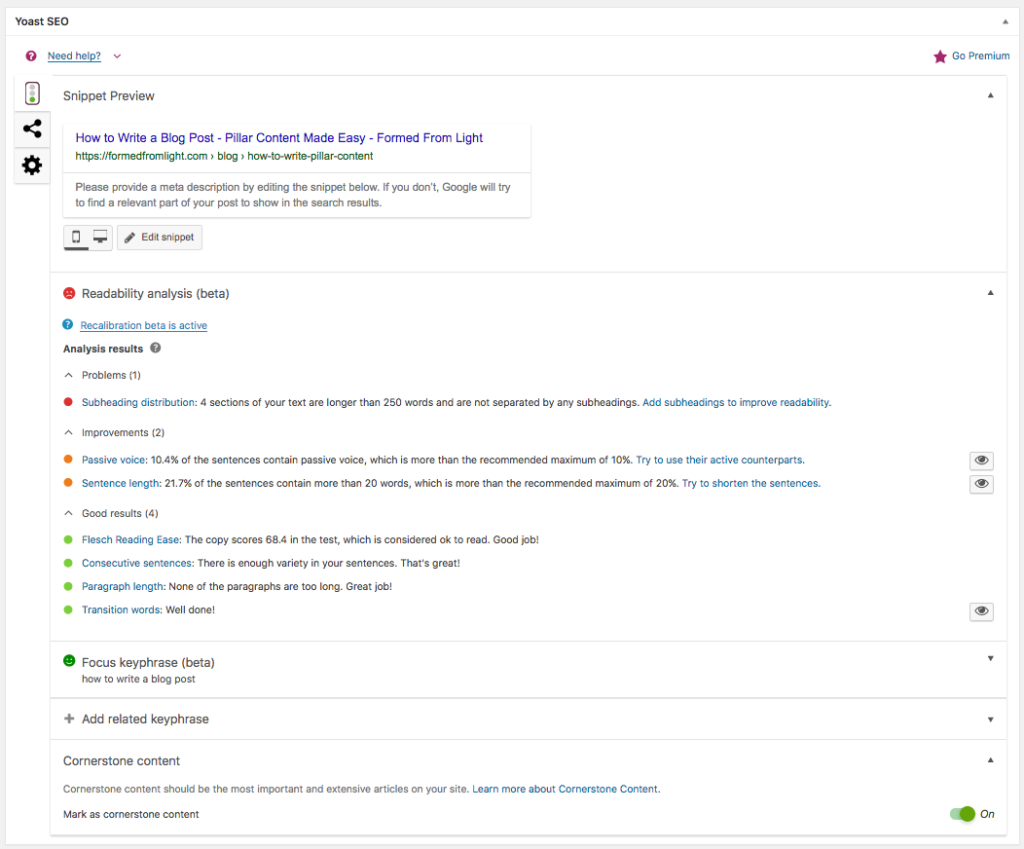Last Updated: February 14th, 2020
In this post, I’m going to teach you how to write a blog post that is of utmost importance: pillar content. Pillar content, also known as cornerstone content, is hugely important to the success of your blog from an SEO perspective. These types of blog articles are designed to be really long, so they give a whole lot of information to search engines like Google and can help you get onto the first page of searches.
I will show you how to write a blog post that can perform well to drive more traffic to your website. On this website, I’ve produced a number of pillar posts already, which you can check out below. Each of these have a few things in common: they are all 10,000+ words long, extremely detailed, provide useful information to my readers, and have helped to increase my site traffic.
Pillar Content Creation – How to Write a Blog Post

1). Select a strong keyword and title
The title of your pillar blog post is very important. It is the first thing most people will see when your website pops up in the search engine. A strong title will include some of the following characteristics:
- Include the target keyword – this tells people your content is relevant to their search
- Incorporate words like “simple”, “easy”, “guide”, and similar as these catch the attention of readers
- The title accurately reflects what will be in the post
According to Yaro Starak in his YouTube video keynote presentation entitled How To Write Great Blog Content – The Pillar Article, pillar article content can assume several different formatting structures such as:
- How to
- Definitions
- Lists
- Opinion
I mention this here because the formatting structure you choose for your pillar article will have a natural connection to the article title or headline that you choose (for example, a ‘how to’ formatted article, like this one you are currently reading, will likely have the actual words ‘how to’ included in your actual article title or headline).
One thing that should be noted when it comes to your post title is how it will impact your permalink. For SEO, you do not normally want to have a really long permalink, so you may find it necessary to edit this to be more concise.
For example, in this post we have our title: How to Write a Blog Post – Pillar Content Made Easy. The permalink has been edited to reflect the title in a short form way: /how-to-write-a-blog-post-pillar-article.
 I find title writing to be fairly straightforward. Normally, I have some idea of what I want to write about, so at least a working title will flow naturally. The more difficult part of writing a pillar article, at least for me, is choosing an effective keyword.
I find title writing to be fairly straightforward. Normally, I have some idea of what I want to write about, so at least a working title will flow naturally. The more difficult part of writing a pillar article, at least for me, is choosing an effective keyword.
Keyword research is a topic covered heavily in How to Start a Blog – A Comprehensive Guide for You. In there, I walk you through the basics of finding a great keyword for free using freely available platforms.
2). Create an outline
Behind every great pillar article is an outline.
It may sound silly, but these types of articles are closer to writing an academic essay than what most people would think blogging is normally like. An outline gives immediate structure to your blog post. It serves a similar purpose to a blueprint for a house that construction workers will build it based off of.
100% – I find a strong and detailed outline helps significantly to lead to better pillar articles. It also reduces the amount of time spent writing and making revisions.
Fortunately, writing a blog post outline is pretty easy stuff! The way I do it looks like this:
- Write down your title – this defines what the whole article will be about
- Use sub-headings to identify the main sections of your post (I suggest the H3 sub-heading)
- In your sub-headings, write down all the main topics you will want to cover – these topics serve as the different sections of your post
By this stage, I’d be happy enough with the detail of my blog post outline. Having the key topics written down helps to give structure to the post already. You can, of course, take your outline deeper if it makes sense by doing the following:
- Outline each of your main topics – you can use additional (and smaller) sub-headings like the H4, H5, and H6 sub-headings to do this
- Begin jotting down some initial thoughts you’d like to share on these topics
In practice, the way this looks is like how I used this strategy in my How to Start a Blog article (it seems I’ll be referencing that one quite a bit here!).
In section #3. Get High Quality Web Hosting, I write a brief intro to this section, then work through the topics I want to cover in this section. These includes questions like “What is Web Hosting?” and “What Makes a Good Blog Hosting Service?” as well as specific discussion on my recommended web host in the section “All About Bluehost“.
Outlining is really rather simple stuff – but often neglected by bloggers.
You can dramatically make your blog posts better just by following this simple tip!!
3). Pull on your experiences
The most engaging blog posts (pillar content or not) include personal experience and your own voice. These are the things that will make your website compelling for someone to read. If it’s not compelling, what’s causing someone to just click off your site and go find someone else’s site?
Now, you will undoubtedly end up writing about things you don’t know a whole lot about. This is maybe the area where it’s hardest to write content because you don’t really have a way to relate to the content. There are a few tricks to tackle these types of situations:
- Go get experience. It’s infinitely easier to write posts about things you are familiar with. You don’t need a professional level of familiarity, either. For example, recently on this website we posted an article reviewing a TV show – Tales by Light Season 3. It would be very difficult to write a review about this show if I didn’t watch it. Sure, it’s possible to do – but the result will be pretty inauthentic. You can see how this same concept can be applied to virtually any thing you write about.
- Document experience of other people who know about the topic. While it’s your blog, incorporating the input from other people can be valuable if done correctly. For example, we write about photography and business topics on our site – since we have a lot of experience with them. But, we occasionally will chat with other photographers and business owners to get input, and incorporate this into our content. We used this approach to create a more interesting article about landscape photography – where we not only include our personal experiences, but experiences of other professional photographers that inspire us.
- Do research. We’re going to talk about this point more in just a second as it’s hugely important regardless of your personal experiences. But, we just want to say – it is possible to write great pillar content even about things you don’t (yet) know a whole lot about…
4). Do research and cite your sources
Every great pillar article includes references to other sources where you found content. Really, learning how to write a blog post begins at the research page. It definitely reminds me of writing papers in school and needing to document all the sources in a bibliography. How different writers go about finding these sources will vary, but I can tell you my process. It’s pretty simple and looks like this:
While writing my post, I’ll come across a topic or point that I don’t know a whole lot about. Or, I know a whole lot, but think my audience could benefit from having more information if they want it. The way I include this information is in the form of a hyperlink to someone else’s article.
For a real world example, we wrote an article titled The Wedding Photography Business Starter Guide. In this, we talk heavily about our personal experiences running a wedding photography business. Early on in the article, we talk about small businesses in general, and talk about some statistics about how many businesses go out of business in the USA. This is something we could just talk about, but it makes more sense to mention it and include a link to a reputable source of this information (in this case – a news website).
See: it’s simple and easy to do!
A quick note: if you have already written an article about a topic you’d like to reference in your pillar article, it is absolutely okay to link to your own content. This is called internal linking – and it’s an essential part of optimizing your website for search engines, as well as user experience in general.
Pro Tip: Be sure that any website article content you link to is relevant, reputable, quality, and has a good page authority (or domain authority). There is much discussion and debate online regarding whether or not linking out to authoritative sources actually benefits your SEO. In 2016, however, a long term experiential research study was done by the marketing firm ReBoot Online which provided results and evidence that “outgoing relevant links to authoritative sites are considered in the algorithms and do have a positive impact on rankings.”
The jury, however, still appears to be out regarding just how much outbound linking is too much.
You can find more suggestions for outbound linking, from your website to other websites, here.
Let us know, in the comments section below, what your thoughts and opinions are on outbound linking!
5). Set a word count goal
 When writing pillar content, one of the important features is that is is long. Of course, you don’t just want it loaded up with filler content – what you are writing should actually be meaningful and useful – but the length of your post does matter. The goal of all pillar content is to rank high in search engines, and providing a lot of content on a single page that is well optimized makes this possible.
When writing pillar content, one of the important features is that is is long. Of course, you don’t just want it loaded up with filler content – what you are writing should actually be meaningful and useful – but the length of your post does matter. The goal of all pillar content is to rank high in search engines, and providing a lot of content on a single page that is well optimized makes this possible.
In general, a pillar article will contain 5,000 or greater words.
More importantly: it should cover the topic in great detail.
In our articles, we always aim for 10,000+ words, mostly because we are a small website looking to really grow and operate under the assumption that really high quality and super long form content will provide long term traffic growth.
While most word processing programs like Microsoft Word, or even WordPress’ built in text editor, will include a word counter – you can also copy/paste your text into a free word counting website like WordCounter to see how many you have written already.
6). Identify the needs of your audience
 Pillar content must be created with your audience in mind.
Pillar content must be created with your audience in mind.
If you are an already established website, your audience may be crystal clear. You might even have hard data, such as can be found in Google Analytics, defining who your visitors actually are. Writing to very specific types of people is fairly easy to do when you know who they are.
The bigger challenge of writing for an “audience” is when you don’t fully know who that audience is!
When I started this website – I did so with a target audience in mind. That is – I started writing content with the idea that I wanted to attract people who fit into a few simple categories:
- Photographers
- Business owners
- Those wanting to get into photography
- People wanting to start a business
- People wanting to start a photography business
As you can see, these classifications range from quite broad to much more specific audiences. With a website like this, not every article I write will apply to ALL of my ideal audiences. The goal is to write content that will apply to at least 1 or 2 of these, and allow for opportunities where there is cross-over.
What is a cross-over audience?
The best way to describe this idea of a cross-over audience is to give you a practical example of how I lay out some of this site’s content. Think about this:
- A viewer comes onto our website after searching into Google: “How Do I Start a Blog?”
- This person clicks on our site, most likely our How to Start a Blog resource
- They are the ideal audience for that specific article, but not necessarily for the whole website
- They read that content and get valuable information from it
- In that post, we talk about our passion for photography on a few occasions – making mention to other posts on our site about that topic such as our 101 Digital Photography Tips article
- Out of curiosity, they click on that link and read about photography…
- Turns out, even though they’ve never taken a picture in their life, they are now interested in getting into photography
After this point, who do you think they’ll turn to for valuable content on photography as they look to purchase gear, want to learn about composition, and maybe one day get so into it that they want to take photographs of their travels or even start a photo business?
As you can imagine, this isn’t going to happen a huge amount of time. Often, when people do searches, they just want immediate gratification on a specific topic. If I type into the search engine “How to cook eggs”, I’m not overly motivated to learn about CSS programming. But, on occasion, there is the chance of that one person who has maybe been interested in programming, but at the time just happened to be hungry and wanted to learn how to prep their food differently.
The cross over audience theory definitely makes sense to me.
I imagine it will probably work out more frequently when the topics are fairly closely related. The steps from photography -> photography business -> general business is not that far fetched, while cooking -> programming language is a pretty big leap.
What do you think?
7). Just write!
The biggest thing that gets in the way of people writing a blog post is the thought that it needs to be perfect right out of the gate. In reality, learning how to write a blog post involves a lot of iteration cycles.
This means: you write a draft, review, revise, rewrite, and repeat until you’re happy with the end result.
In my How to Start a Blog pillar post, you can see in the below screenshot this went through 174 revisions based on the counter in WordPress. For a post that is over 15,000 words long – it’s easy to see how this much revising would be necessary.

So, if you should do anything, it is that you need to literally just start writing. You can always fix mistakes, add more content, remove content, and so on at a later point. Just start by getting your ideas out of your head and on paper.

Side note: if you don’t watch Parks and Recreation, you should.
8). Incorporate many relevant images
With your content written, you can pat yourself on the back as you have now learned how to write a blog post of this nature. The writing part is, honestly, the hardest. It is also the most time consuming.
To really make a great piece of pillar content, you need to now integrate images that make sense with your content and audience. These can include photographs, infographics, charts, memes…you name it. We get our image content from our personal photography work, as well as free stock image websites like Pexels. We also create more complex content in Photoshop or through Design Wizard – an easy to use creative suite for putting together web content imagery.
9). Take your time to create excellent content
 I’ve talked about the pillar articles I’ve written for this website already – and each one took at least a couple of weeks to put together. Granted, I had to work on them on the side of my business, day job, and other life responsibilities – but they are definitely not a quick job.
I’ve talked about the pillar articles I’ve written for this website already – and each one took at least a couple of weeks to put together. Granted, I had to work on them on the side of my business, day job, and other life responsibilities – but they are definitely not a quick job.
Pillar content should not be rushed. The real goal of this type of content is to be the top of it’s class. It enables small websites to push huge corporate content lower in the search engines. Think about that for a second!! Is is hugely powerful if you are able to get your website to rank higher than the “big guys” in your industry, as you will end up taking some of their potential viewers and converting them into your own.
There is a reason why I take my time to put together my content. I want it to serve many purposes such as:
- Provide real valuable to my readers
- Give me some value through new viewers, life long readers, and money through marketing efforts
- Represent my brand well
Great content is hard to come by. It’s especially true when it is being offered up for free. So, put in the hard work to create something truly great, and you will be recognized for it over time.
10). Mark it as “Cornerstone Content”
If you are using WordPress to blog, it’s critical that you get Yoast SEO and utilize the “Cornerstone Content” option for your pillar posts. Pillar posts are also known as cornerstone content. This is because they form the cornerstone of what your website is about. By marking it accordingly, it signals to the search engines that “Hey! This particular post is really extensive and represents all the good my website has to offer.”

Yoast SEO is a free plugin that can also be upgraded to a premium version with more extensive features. Highly recommended!
11). Promote pillar content regularly
I personally find pillar content relatively easy to write at this point. I’m experienced enough with writing in all types of situations. It sometimes stinks to have to spend weeks on end putting together a post, but I also acknowledge that it is worth it when done correctly.
I say this because once you’ve actually completed your post, there is still work to be done!
The quote “If you build it, they will come” from Field of Dreams does not apply to web content (as much as I wish it did).
You need to actively promote your pillar content. This can be done through your social media accounts, as well as on forums and other places. Even more critical is getting in touch with other bloggers to get backlinks to it – a vital part of any SEO strategy. Sometimes this is easier said than done, and it may require you to do extra work putting together a guest post for those bloggers.
One area you do have a lot of control, though, is in making sure you backlink to your pillar content from other articles you write on your site. For example: I wrote a huge article talking about my experiences traveling to Iceland in a post called Reflection on Our 10 Day Adventure in Iceland – One Year Later. It brought in a nice amount of traffic on it’s own, but I’ve since written a number of other articles that refer to it such as Breaking Down the Cost to Travel to Iceland for 10 Days.
12). Update pillar content as needed
 Finally…the moment you’ve all been waiting for…
Finally…the moment you’ve all been waiting for…
Your beautiful piece of pillar content stands as an example of how to write a blog post. The content is so valuable that it brings in new readers consistently, but there is a catch. Other bloggers will catch on and take notice, and may try to replicate what you have created – and even try to surpass it.
To keep your article relevant for years to come, it’s important to periodically update it with new information.
Just like home ownership, buying a nice house is great, but over time you will want to make repairs and even update things like kitchen appliances. Updating your cornerstone articles is exactly like this!
When it makes sense, open up your post and make some edits. Here are a few things we look to add in our own content:
- Reference news articles or studies about the topic that really enhance the value of your content.
- Talk about a new product (that is relevant) you started to use that help you achieve the goals of your content topic.
- Include more calls to action to get your readers more involved in the comments to keep them fresh
I’m sure you can think of some more things you can update too, so leave a comment letting me know what 🙂
How to Write a Blog Post – Pillar Content Edition
Learning how to write a blog post of the pillar article variety has not been to hard (at least – I hope not!). Now, it’s your turn. I challenge you to put together an immensely valuable piece of content that your readers (current and future) will benefit from.
If your post isn’t taking off immediately, don’t get discouraged. Know that it will take time – up to 10 months in some cases – to rank in search engines. But once it does, it’s a staple piece of content that will drive new traffic to your site over and over again.
If you choose to act what I wrote about in this post and put together your own pillar article, definitely return here and leave a link to it. I’d love to check it out, and maybe even link back to your post sometime!